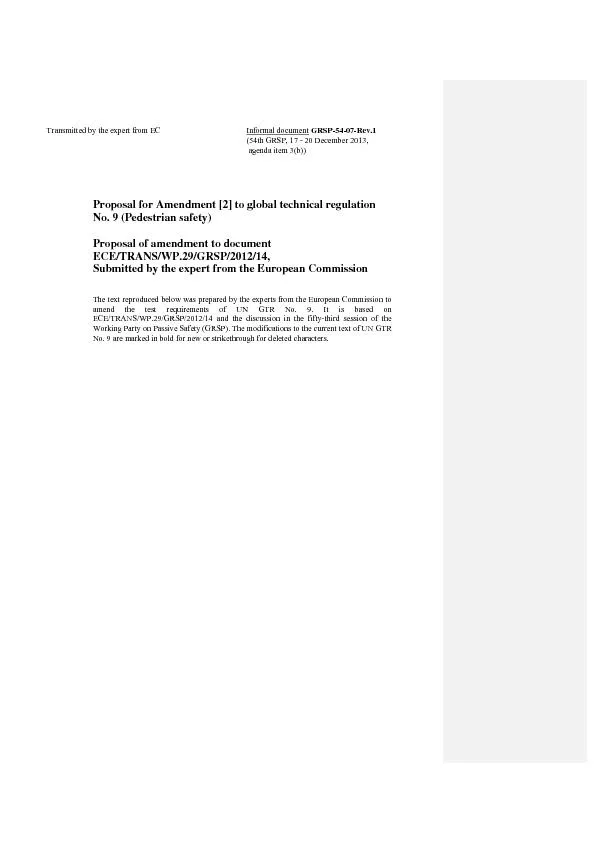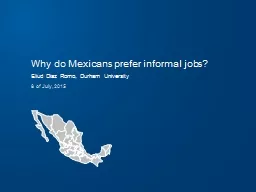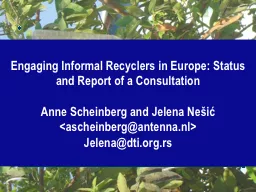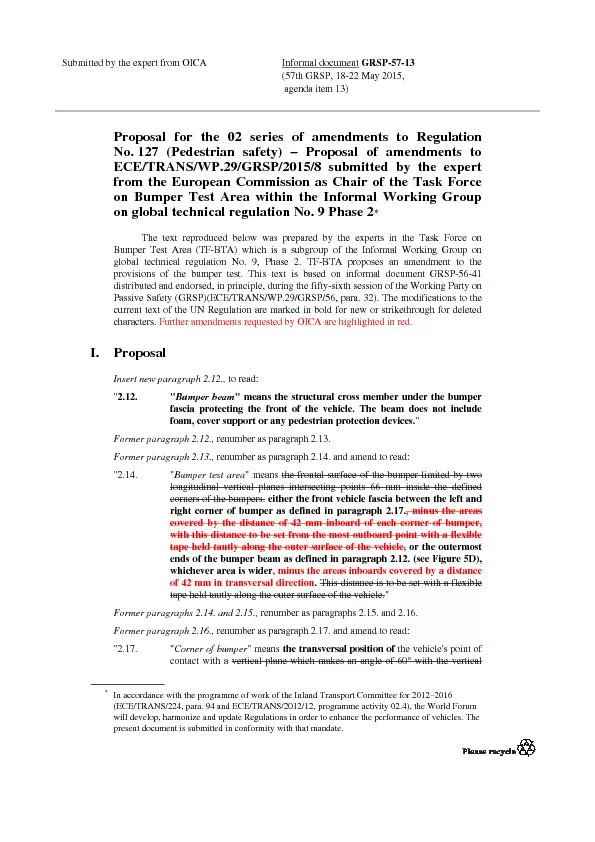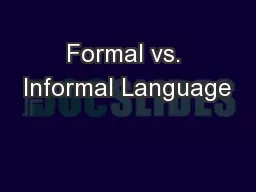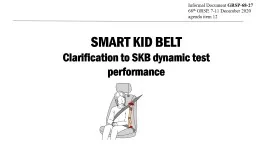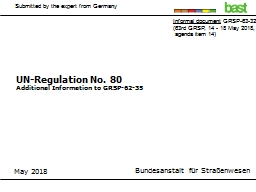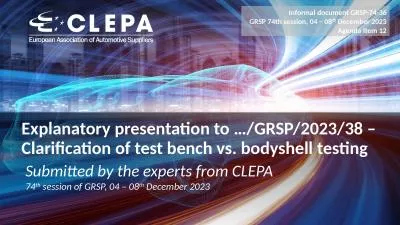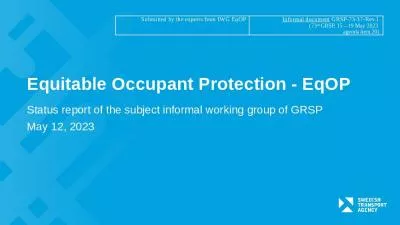PDF-Transmitted by the expert from EC Informal document GRSP-54-07-Rev.1
Author : lindy-dunigan | Published Date : 2016-08-11
54th GRSP 17 20 December 2013 agenda item 3b Proposal for Amendment 2 to global technical regulation No 9 Pedestrian safety Proposal of amendment to document ECETRANSWP29GRSP2
Presentation Embed Code
Download Presentation
Download Presentation The PPT/PDF document "Transmitted by the expert from EC Inform..." is the property of its rightful owner. Permission is granted to download and print the materials on this website for personal, non-commercial use only, and to display it on your personal computer provided you do not modify the materials and that you retain all copyright notices contained in the materials. By downloading content from our website, you accept the terms of this agreement.
Transmitted by the expert from EC Informal document GRSP-54-07-Rev.1: Transcript
54th GRSP 17 20 December 2013 agenda item 3b Proposal for Amendment 2 to global technical regulation No 9 Pedestrian safety Proposal of amendment to document ECETRANSWP29GRSP2. 16 Safetybelts I Proposal Republic of Korea proposes that the mandatory installation of the Safetybelt Reminder be extended to the backseat II Background Recently the Korean government has made it mandatory for passengers to wear seatbelts in the ba Using Formal and Informal Language Appropriately. Everyday life is not like a Grey Poupon Commercial…. . Most of us remember the Grey Poupon commercials of the 90’s where a man in a limousine is asked for some fancy mustard and replies, “But, of course!” We all inherently know why the commercials are amusing, but we probably haven’t taken the time to actually analyze the reasoning.. Planning . - . Always spend a few minutes planning what you will say and to whom – get your audience right! . Ordering. - . Organise the order in which you present and structure your ideas . Layout (on slide below). ?. Eliud Diaz . Romo. , Durham University. 8 of July, . 2015. Understanding informal labour in Mexico. Methodology. Data. Estimations. Why do Mexicans prefer informal jobs?. Título de la sección. Understanding informal labour in Mexico. Anne Scheinberg and Jelena Nešić. <ascheinberg@antenna.nl>. Jelena@dti.org.rs. 1. Structure of this Presentation. Introduction: recycling, puzzle or promise. Service chain and value chain. The power of a . (57th GRSP, 18-22 May 2015, agenda item 13) Proposal for the 02 series of amendments to Regulation No. 127 (Pedestrian safety) Curriculum links. Covers E3-L2 Functional English. . E3 Write texts with some adaptation to the intended audience . L1Use language, format and structure suitable for purpose and audience. L2 Use a range of writing styles for different purposes . What is the difference?. Characteristics of formal . language:. Serious. Objective . Specific vocabulary. No contractions. More complex sentences. Controlled. Impersonal. When do we use formal language?. La gamme de thé MORPHEE vise toute générations recherchant le sommeil paisible tant désiré et non procuré par tout types de médicaments. Essentiellement composé de feuille de morphine, ce thé vous assurera d’un rétablissement digne d’un voyage sur . Informal document : GRSP-64-37 (64th GRSP, 11 - 14December 2018, agenda item 9) Introduction to Revision of UNR17 Proposal Document ECE/TRANS/WP.29/GRSP/2018/34 Alignment to GTR No. 7 head restraints SKB. dynamic test performance. Informal Document . GRSP-68-27. 68. th. GRSP, 7-11 . December. 2020. agenda item 12. . GRSP. 7- 11 December 2020. During last year there have been plenty different unsubstantiated allegations towards Smart Kid Belt (. May 2018. Submitted by the expert . from Germany. Informal document. . GRSP-63-32. (63rd GRSP, 14 - 18 May 2018,. . agenda item . 14. ). UN-Regulation . No. . 80. The current UN-Regulation No. 80 allows to approve large passanger vehicle seats and their anchorage according to two different test procedures.. Informal . document GRSP-74-36. GRSP 74th session, 04 – 08. th. December 2023. Agenda Item 12. Submitted by the experts from CLEPA. 74. th. session of GRSP, 04 – 08. th. December 2023. Aims of the proposal. - . EqOP. Status report of the subject informal working group of GRSP. May 12, 2023. Submitted by the experts from IWG . EqOP. Informal document. GRSP-73-37-Rev.1. (73. rd. GRSP, 15 – 19 May 2023 .
Download Document
Here is the link to download the presentation.
"Transmitted by the expert from EC Informal document GRSP-54-07-Rev.1"The content belongs to its owner. You may download and print it for personal use, without modification, and keep all copyright notices. By downloading, you agree to these terms.
Related Documents

